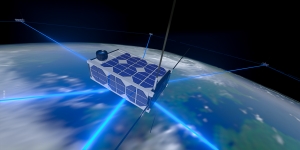As history has shown, The Netherlands is a small country capable of great things. This also goes for shaping the future of small satellites, says Michel Keuning, Head of ISR & Space Utilization at NLR-Netherlands Aerospace Centre.
So, what does the future look like?
‘We’ll see more and more constellations of small satellites, working together to accomplish a mission. The great advantages are vastly increased spatial and temporal coverage of the earth. New architectures enable greater versatility and dependability and using state-of-the-art electronics components boosts performance by up to two decades. If you have a lot of small satellites in new architectures, some can for example be dedicated to measurements, while others can communicate data to Earth. And by orbiting spares, even if some of the satellites fail to perform their task, you’ll still have plenty in orbit to take over.’
What can small satellites improve in terms of mission objectives?
‘With many satellites working together in a constellation, it will be possible to increase the frequency of observations, build large fragmented instruments, build quick response capabilities, and all at a competitive price.’
Sounds very expensive…
‘In recent years it has become clear that quite some off-the-shelve-technology work perfectly fine in low earth orbit. Where we used to spend millions of euros and ten to fifteen years on technology development and de-risking, we can now use relatively low cost solutions based on the technology billions of people carry around in their pockets.’
Will small satellite applications become part of our daily life soon?
‘Think of the speed with which the internet has changed our lives. Right now, there is no equivalent to that in space. I see endless possibilities there. Many practical applications would benefit from constellations of small satellites, since they have the unique ability to cover any place on Earth.’
What are the biggest challenges?
 ‘Data processing, communication, and storage are a major challenge. Lots of satellites create a lot of data. Together with our partners, we are working on processing more data in orbit so the constellation can downlink only what we need.
‘Data processing, communication, and storage are a major challenge. Lots of satellites create a lot of data. Together with our partners, we are working on processing more data in orbit so the constellation can downlink only what we need.
A second challenge is building small satellite constellations responsively. We want to be able to put a constellation in space in a matter of weeks. That way, they can also serve military, humanitarian and civil purposes related to for example crisis situations. For this to happen, the space industry has to get familiar with industrialization.’
Why is The Netherlands a front runner in the development of small satellite constellations?
‘The Netherlands was a very early adopter of small satellites and we now have market leading space industry in that sector. NLR has the ambition to fortify that position for the future in cooperation with users, the industry and SMEs. With applications ranging from defence and security to precision agriculture, small satellites have a very bright future. And Dutch companies are positioned well to take a lead into the future.’
SMILE: small launcher for small satellites

Photo credits: Small Sat Launcher [NLR/NASA]
Small satellites often ‘hitch a ride’ on a large rocket that is dedicated to a primary customer. This can cause conflicts with respect to the timeline and the target orbit. Now that smaller satellites become technologically more advanced and mature, the need is growing for dedicated but ‘affordable’ launches for small satellite operators.
Fourteen European companies and institutes took up the challenge and joined forces in the European Union (EU) Horizon 2020 project called SMall Innovative Launcher for Europe (SMILE). The project aims at designing a launcher for satellites up to 70 kg from a European-based launch facility at Andøya, Norway, as well as demonstrating critical technologies on propulsion, avionics, and manufacturing of cost-effective solutions.
NLR maintains the ambition to support and accelerate the development of European independent access to space for small satellites, with focus on excellence in: affordable lightweight structures, cost effective avionics, and goal oriented (sub)systems engineering.
See also the SMILE website: https://www.small-launcher.eu/
SMILE is co-funded by the European Union. This message doesn’t necessarily reflect the views of the EU.
For more information: Michel Keunig
